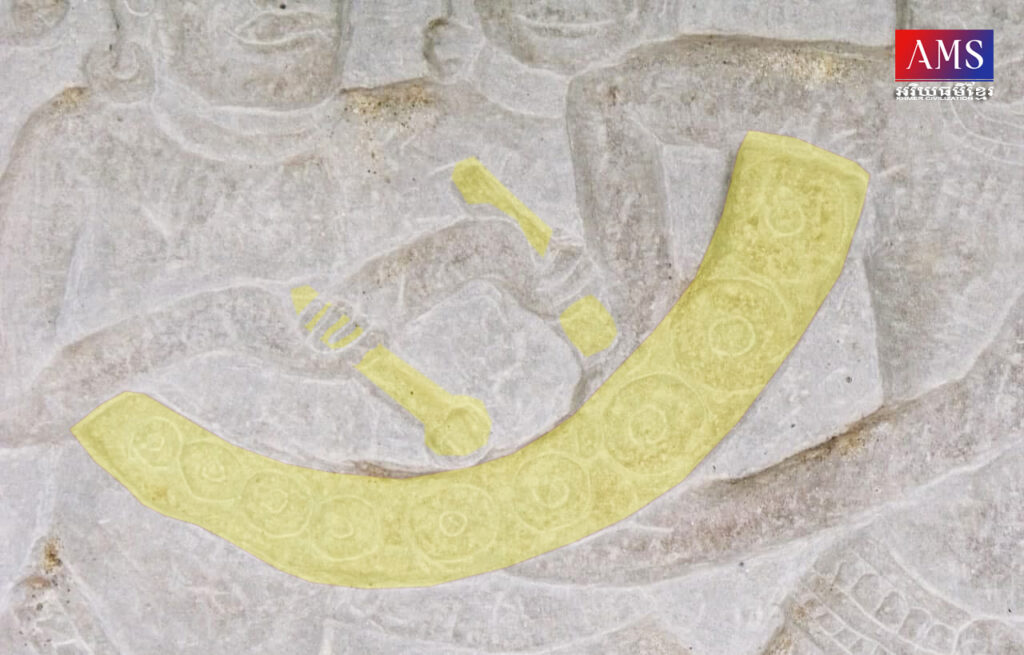កម្ពុជា ជាព្រះរាជាណាចក្រនៃវប្បធម៌ ប្រកបដោយវប្បធម៌និងអរិយធម៌កំពូលរុងរឿងសម្បូណ៌បែប មានសិល្បៈទស្សនីយភាពជាងម្ភៃទម្រង់ ឧបករណ៍តន្ត្រីជាងមួយរយដែលខ្មែរបាននិងកំពុងប្រើប្រាស់នៅក្នុងវង់តន្ត្រីជាងម្ភៃវង់។ ភាពសម្បូណ៌ ហូរហៀរនៃឧបករណ៍តន្ត្រីនេះ គឺដោយសារកត្តាមួយចំនួន រួមមានកត្តាធម្មជាតិ មានដីឥដ្ឋ ឫស្សី ឈើ រុក្ខជាតិ ដែក ស្ពាន់ លង់ហិន មាស ប្រាក់ ជ័រ ស្បែក សក់ ឆ្អឹង ភ្លុក និងសម្បកខ្យងជាដើម ដែលខ្មែរយើងយកមកច្នៃផលិតទៅជាឧបករណ៍តន្ត្រី។
«វប្បធម៌ស្ពាន់កម្ពុជា» មានអាយុកាលមុនសម័យគ្រឹស្តសករាជ្យ គឺសម័យបុរេប្រវត្តិសាស្ត្រ។ តឹកតាងបុរេប្រវត្តិសាស្ត្រ បានបន្សល់ទុកដល់បច្ចុប្បន្ននូវ រនាតថ្ម ស្គរមហោរធឹក ស្គរហៅទឹកភ្លៀង ជួង គ្រឿងតុបតែង របស់ប្រើប្រាស់ប្រចាំថ្ងៃ ប្រាសាទបុរាណ និងសិលាចារឹក ដែលផ្តល់ឱ្យយើងជាអំណះអំណាង អំពីវត្តមានជាក់ស្តែង និងប្រវត្តិសាស្ត្រដ៏វែងនិងយូរលង់នៃវប្បធម៌ស្ពាន់របស់ខ្មែរ។ ភស្តុតាងទាំងនេះ យើងបានរកឃើញនៅក្នុងតំបន់បុរាណវិទ្យាខ្មែរនៅ សម្រោងសែន និងអន្លុងផ្តៅ ខេត្តកំពង់ឆ្នាំង ក្បាលរមាស ខេត្តព្រះវិហារ ល្អាងស្ពាន ខេត្តបាត់ដំបង ស្រែស្បូវនិងភ្នំរលួស ខេត្តក្រចេះ និងមេមត់ ខេត្តកំពង់ចាម ។
សម័យអង្គរខ្មែរដ៏មហាលូតលាស់រុងរឿង (សតវត្សទី៩-១៥) បានបន្សល់ទុកនូវប្រាសាទបុរាណតូចធំជាងមួយពាន់ប្រាសាទ ដែលជាភស្តុតាងប្រវត្តិសាស្ត្រក្នុង រូបភាពជាចម្លាក់និងសិលាចារឹក អំពីជីវិតរស់នៅប្រចាំថ្ងៃរបស់ព្រះមហាក្សត្រ និងប្រជាពលរដ្ឋសាមញ្ញ ជំនឿសាសនា ព្រមទាំងវត្តមានរបាំនិងតន្ត្រី មានឧបករណ៍ពិណ ខ្សែមួយ ស្រឡៃ ត្រែ ស្នែង ពាទ្យ គង ឆាប ឈឹង និងស្គរជាច្រើនប្រភេទ។
ខ្មែរយើងប្រើឧបករណ៍ដែលបានរៀបរាប់ខាងលើ នៅក្នុងវង់តន្ត្រីបច្ចុប្បន្ន ដែលយើងអាចសន្មតបានថា ទម្រង់និងទ្រង់ទ្រាយប្រពៃណីតន្ត្រីខ្មែរបច្ចុប្បន្ននេះ ពិតជាមានប្រភពដើម និងមានការបន្តនូវប្រពៃណីតន្ត្រីពីសម័យអង្គរនិងមុនអង្គមកម៉្លេះ។ ហើយខ្មែរជំនាន់ក្រោយអង្គរ ក៏មានការច្នៃប្រឌិតនិងអភិវឌ្ឍបន្ថែមទៅលើវប្បធម៌អង្គរថែមទៀត។
បើយើងសង្កេតទៅលើសំណេរ អត្ថបទ និងសៀវភៅជាច្រើនពាក់ព័ន្ធនឹង លោហធាតុ យើងឃើញថាខ្មែរប្រើពាក្យ «លង់ហិន» សម្រាប់ពាក្យអង់គ្លេស bronze និង brass ។ តាមរយៈការសិក្សា ស្រាវជ្រាវ និងជំរឿនអំពីវប្បធម៌ស្ពាន់នៅកម្ពុជា ខ្ញុំរកឃើញថាមានឧបករណ៍តន្ត្រីចំនួន១៩ ដែលផលិតពីស្ពាន់ លង់ហិន ដែក និងលោហធាតុផ្សំ គឺស្មើនឹងប្រមាណ២០ភាគរយនៃឧបករណ៍តន្ត្រីខ្មែរទាំងអស់។ ឧបករណ៍ទាំងនេះមានដូចជា៖ ស្គរមហោរធឹក ឬ ស្គរមហាឫទ្ធិ ស្គរហៅទឹកភ្លៀង ជួង គងញី គងឈ្មោល គងម៉ង់ គងធំ គងតូច ឃ្មោះ ឆាប ឈឹង រនាតដែក រនាតថោង ពាទ្យ គងវង់តូច គងវង់ធំ កណ្តឹង ចង្ក្រង់ និងអង្កួច (កង្កួច)។
តាំងពីបុរាណកាលមក តន្ត្រីខ្មែរនៅជាប់ជាមួយនឹងធម្មជាតិ កសិកម្ម និងពិធី បុណ្យទានប្រពៃណីនិងសាសនាផ្សេងៗនៅក្នុងជីវិតខ្មែរ ដូចជាពិធីបុណ្យកំណើត កោរជុក បំបួសនាគ អាពាហ៍ពិពាហ៍ បញ្ជាន់និងលៀងអារក្ខ សព រហូតដល់ព្រះរាជពិធីចម្រើនព្រះជន្មនិងគ្រងរាជ្យ។ ឯឧបករណ៍តន្ត្រីខាងលើ គឺគេប្រើប្រាស់នៅក្នុងវង់តន្ត្រីខ្មែរដ៏សម្បូណ៌បែបដែលពាក់ព័ន្ធនឹងជីវិតខ្មែរខាងលើនេះ។
ឧបករណ៍តន្ត្រីដែលធ្វើពីស្ពាន់ គឺនៅមានប្រើប្រាស់ក្នុងចំណោមជនជាតិដើមភាគតិចនៅកម្ពុជា ទោះបីនៅក្នុងកំរិតតិចតួចក៏ដោយ ដែលជាតម្រូវការដើម្បីកំដរ ពិធីប្រពៃណីផ្សេងៗ ដូចជាពិធីធ្វើចម្ការ ដាំស្រូវ ច្រូតស្រូវ សែនស្រូវ អាពាហ៍ពិពាហ៍ គ្រោះមហន្តរាយ រោគនិងជំងឺ បញ្ចូលនិងលៀងអារក្ខ កាប់ក្របី និងសពជាដើម។ តាមរយៈការស្រាវជ្រាវដែរ ខ្ញុំក៏សង្កេតឃើញថាជាការសោកស្តាយមួយ ដែលជនជាតិភាគតិចយើងនៅកម្ពុជា មិនបានផលិតគងដោយខ្លួនឯងនិងបែរទៅទិញពីអ្នកជិតខាងយើងទៅវិញ។
នៅក្នុងន័យនេះ ខ្ញុំគិតថា ប្រសិនបើយើងមិននាំគ្នាបណ្តុះសតិស្មារតីនិងមនសិការស្រឡាញ់វប្បធម៌ប្រពៃណីទាំងនេះ ហើយនាំគ្នាអភិរក្ស ថែរក្សា ស្រឡាញ់ គោរព តម្លៃ ការពារ ផ្សព្វផ្សាយ និងបណ្តុះបណ្តាលជាបន្តនោះទេ សម្បត្តិវប្បធម៌នេះនឹងប្រឈមការបាត់បង់ ឬឳនថយនៅនាថ្ងៃអនាគតពុំខានឡើយ។ លើសពីនេះទៅទៀតយើង ជាពិសេសយុវ័យបានកំពុងនឹងបន្តប្រឈមនឹងបរិបទសាកលភាវូបនីយកម្ម ដែលហូរចូលមកកម្ពុជាក្នុងទ្រង់ទ្រាយដ៏ធំ ប្រៀបបាននឹងទឹកបាក់ទំនប់ហូរចូលមកទាំងរឿងវិជ្ជមាននិងអវិជ្ជមាន ដែលយើងជាអ្នកទទួលត្រូវគិតពិចារណា ជ្រើសរើសយកអ្វីដែលជាផលប្រយោជន៍នាំមកនិងធ្វើឱ្យវប្បធម៌ប្រពៃណីរបស់យើងរីកចម្រើនទៅមុខ។
យើងគួរតែស្នើដាក់បញ្ចូលឧបករណ៍និងវង់តន្ត្រីគង ទៅក្នុងបញ្ជីបេតិកភណ្ឌវប្បធម៌អរូបីនៃមនុស្សជាតិនៃអង្គការយូណេស្កូ ដើម្បីជាការទទួលស្គាល់ថ្នាក់ជាតិនិងអន្តរជាតិពង្រឹងមនសិការនិងស្មារតីកូនខ្មែរ និងដើម្បីគាំទ្រ ទ្រទ្រង់អភិរក្ស ថែរក្សា ការពារ បណ្តុះបណ្តាល និងផ្សព្វផ្សាយ ដើម្បីលើកស្ទួយការពារ បន្តសម្បត្តិវប្បធម៌នេះ ទៅនាពេលអនាគតជានិរន្តន៍តរៀងទៅ។
———————————————-
Culture and Musical Instruments Made of Metal in Cambodia
Cambodia is home to over a hundred musical instruments and over two-dozen music ensembles. The richness of this musical tradition owes itself to the heavenly blessed natural resources from which musical instruments are made, i.e., clay, bamboo, wood, plants, iron, copper, brass, bronze, nylon, and animal parts (gut, skin, hair, bone, ivory, and shell).
Bronze culture of Cambodia dated back to the country’s prehistory, i.e., before the first century of the Christian era. However, little is known about this period of Cambodia’s history. The existing evidence of prehistorical remains, including lithophones, bronze drums, bells, ornaments, daily life utensils, ancient Khmer stone monuments, and epigraphy provide convincing accounts and attest to the prominent presence and lengthy history of Khmer bronze culture. Those evidences are found at the Khmer archeological sites of Samraong Saen and Anlung Phdao (Long Prao) in the province of Kampung Chhnaing, Kbal Romeah in the province of Preah Vihear, La-ang Spean in the province of Battambang, Srae Sbauv and Phnom Roluoch in the province of Kracheh, and Memut in the province of Kampung Cham (Troeung 2003[1973]: 22, Khun 2002: 58).
Angkor, the most glorious and culminating period of Khmer history (9th-15th centuries), left for us today with over one thousand ancient stone monuments, large and small, and contains important historical evidence on carvings of court and commoner’s daily lives, religious beliefs, and practices, as well as accounts on dance and musical instruments, such as Pinn (angular harp), Khsae Muoy (monochord), Sralai (oboe), peat (half-moon gongs), korng (knobbed and flat gongs), chhap (small cymbals), chhing (small finger cymbals), and various types of drums (skor).
The make-up of music ensembles in Cambodia today includes the aforementioned instruments found during the Angkor period, but in a more developed form. Consequently, we have every reason to believe that the present musical tradition of Cambodia is the living continuation of the tradition of Angkor and earlier.
The Khmer do not strictly make a distinction between bronze and brass. They are translated as “Lunghenn” (Headley et al. 1977:908). However, as far as acoustic and sonority are concerned, bronze has a darker sound than brass, whereas brass has a brighter sound than bronze. By way of research, study, and survey of bronze culture in Cambodia, I find nineteen musical instruments made of bronze, brass, copper, or iron, constituting less than 20 percent of the total number of musical instruments in Cambodia. They are:
Skor Moho Thoeuk Bronze Drum
(also called Skor Moha Ritt)
Skor Hao Toeuk Phlieng Bronze Drum
Chuong Bell
Korng Nhi Bossed Gong
Korng Mong Small Bossed Gong
Korng Tauch Small Bossed Gong
Korng Thomm Large Bossed Gong
Korng Chhmol Flat Gong with thick rim
Khmuoh Flat Gong with thin rim
Chhap Cymbals with thin rim
Chhing Small Finger Cymbals with thick rim
Roneat Daek High-Pitched Metallophone
Roneat Thong Low-Pitched Metallophone
Peat Half-Moon Gongs
Korng Vung Tauch High-Pitched Circular-Framed Gongs
Korng Vung Thomm Low-Pitched Circular-Framed Gongs
Kandoeung Small Bell
Changkrang Rattles/Shakers
Angkuoch Jew’s Harp
Since the olden times, Khmer music has been associated with and inspired by the village life and its natural environment. Music events are centered around national, traditional, and religious rituals and ceremonies, which are called for, be it birth, ordination, marriage, funeral, installation of a village chief, or the crowning of a king or queen.
The above listed bronze-type of instruments are used in various situations and contexts, in ensembles accompanying rituals, ceremonies, dance and theater accompaniment, or mere entertainment.
It has been practiced and still prevails today, although perhaps to a lesser extent, among the Khmer and the indigenous ethnic groups, gong ensembles function within the contexts of field clearing, rice planting, and harvesting, wedding, village famine and catastrophe, illness, funeral, as well as courtship and entertainment.
From my years of research among the indigenous ethnic groups in Cambodia, I find it sad that gongs are no longer made in Cambodia. They are purchased from the neighboring countries. If nothing will be done about it in the near future, these invaluable traditions will be in danger of disappearing. It has already been in a steep decline in practice.
Globalization adds another dimension, both positive and negative, to the effort of conserving, preserving, innovating, creating, safeguarding, protecting, promoting, and sustaining the priceless Khmer culture, in general, and gong traditions, in particular, in Cambodia.
Further attention must be paid to the priceless gong tradition. We must increase research, study, and publication on music and the lives of the concerned practitioners. I propose to have the Khmer Gong Ensembles designated as the UNESCO World Intangible Cultural Heritage of Humanity.
អត្ថបទដើម៖ បណ្ឌិត សំ សំអាង










